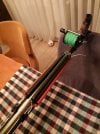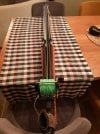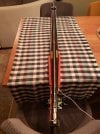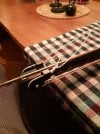Hi guys,
Recently, I made a home-made invert roller by combining different parts. Eventually, I came up with a 100mm gun with following parameters:
- Carbon body
- Roisub invert roller head
- 3 x 14mm rubber band
My first combination was with 7mm 140cm shaft. However, the balance was not good as the head was floating. So I changed that with 150mm 7mm shaft. Right now, the balance is good but the performance is below my expectation. The shaft is not moving strong enough to move 5m string. The stretch ratios of rubber bands are roughly in the range of 300-340%. It seems that the effective range is not more than 3-3,5m
Do you think that it is normal? Will it help replace the existing shaft by 6,5mm 150cm? Or better to shorthen rubber band and check?
Thanks in advance for your feedback
Recently, I made a home-made invert roller by combining different parts. Eventually, I came up with a 100mm gun with following parameters:
- Carbon body
- Roisub invert roller head
- 3 x 14mm rubber band
My first combination was with 7mm 140cm shaft. However, the balance was not good as the head was floating. So I changed that with 150mm 7mm shaft. Right now, the balance is good but the performance is below my expectation. The shaft is not moving strong enough to move 5m string. The stretch ratios of rubber bands are roughly in the range of 300-340%. It seems that the effective range is not more than 3-3,5m
Do you think that it is normal? Will it help replace the existing shaft by 6,5mm 150cm? Or better to shorthen rubber band and check?
Thanks in advance for your feedback







